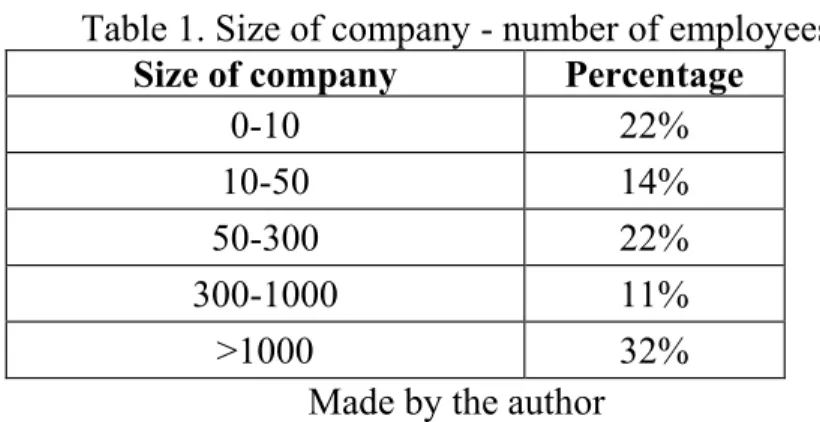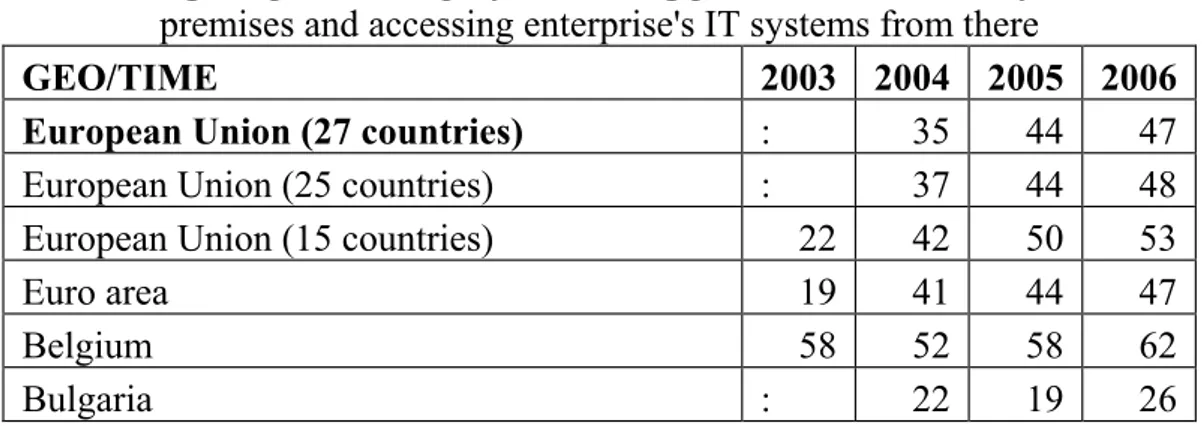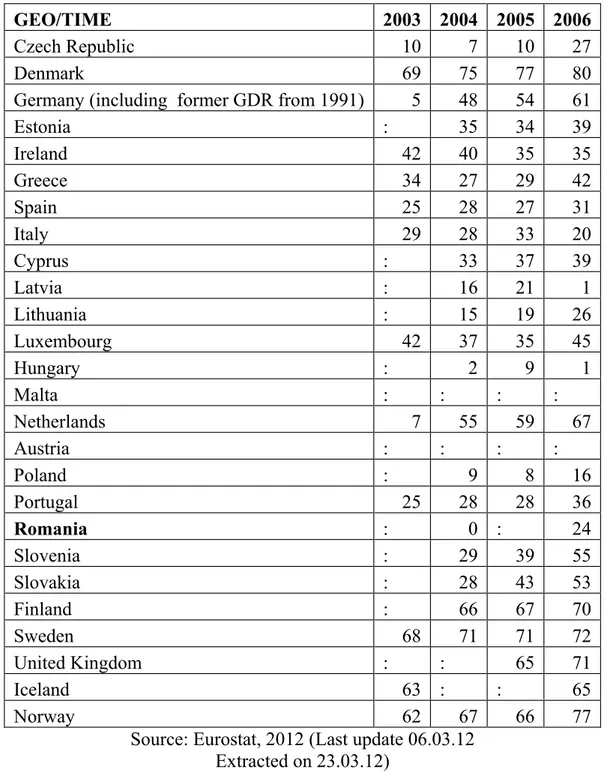RESEARCH ON THE IMPACT OF ICTS ON THE LOCATION AND SPATIAL
DEVELOPMENT OF FIRMS
Schwartz Andrei
The West University of Timişoara Faculty of Economics and Business Administration
This article resulted out of primary data produced on the basis of PhD level research of the use of information and communication technologies (ICTs) in, primarily, professional services firms located in Romania and the broader European spectrum. We have aimed at seeing whether ICTs produce a spatial effect on firms (such as their launching of new offices or hiring of remote workers, in places where the firm does not have branches. Among the chief conclusions of this paper, we have highlighted the idea of how companies should be encouraged to conceptualize the ease with which they can locate their branches wherever so as to capitalize on two aspects: a broader market for their services and products as well as tapping into reservoirs of talent in lower cost countries .
Keywords: ICTs, location, research, Internet, SMEs JEL code: R1
I. Introduction
With gasoline prices skyrocketing around the world as a result of both increased demand and the instability of autocracies and teocracies in most OPEC countries, as well as with the added stimulus of having a reliable tellecomunications network connecting most countries, many firms as well as their employees started looking, with the start of the latest financial crisis, into other, more modern, ways of working. One oif the reasons was obvisouly reducing costs in their operation. Another was simply, doing things smarter and in a more efficient way.
Alternatives started then being implemented, such as transit subsidies, carpooling with other colleagues or other means through which the employees would commute to the company’s HQ. The one other major new idea which was researched and implemented starting in the USA (either through careful strategy and planing or through the natural course of action of using the ICTs): telecommuting or telework (the later is the EU preffered term for the subject).
The proliferation of high-speed, broadband Internet connectivity and the existance of smartphones also occurred during the later half of the first decade of the 21st century, all this helped telework become a well accepted and, by many employees, desired way of working for many companies and individuals worldwide.
And last, but surely not the least, people started appreciating more and more a better balance between personal life and working time. All this could be facilitated via flexible-time, remote working.
II. Research methodology
We wanted to research some of the hypotheses presented in our introduction and the way we chose to do it was via applying a questionnaire. We have mostly used quantitative tools and data, to add volume to the perceptions which already resulted through some 1 on 1 interviews with managing directors of companies – that being the bulk of the qualitative information.
We’ve sent invitation letters for the questionnaire to over 950 individuals through the business network LinkedIn (www.linkedin.com). The response rate was surprisingly good for such a research project (close to 10%).
We’ve presented some identifying data on the sample population we’ve researched in the tables below (Tables 1 through 3).
Table 1. Size of company - number of employees Size of company Percentage
0-10 22%
10-50 14%
50-300 22%
300-1000 11%
>1000 32%
Made by the author
Close to 60% of the respondents (adding up 22%+ 14%+22%) come from firms with less than 300 employees, making this sample population relevant, primarily for SMEs (Small and medium enterprises).
Table 2. Activity domain of the company Industry Percentage Translation services 5% IT/High-tech/software 30%
Design/Digital 2%
Marketing/PR/Communications 12%
NGOs 5%
Telecommunications 5%
Banking and finance; insurance 8% Other professional services 33%
Made by the author
We can see that the majority of the firms represented in our study are in the tertiary area of the economy, being service providing firms.
In table 3 we have presented the geographical spread of respondents. Instead of presenting each country, we have highlighted the continents they represent.
Table 3.Location of respondents Continent Percentage
Europe 78.1%
Asia 9.6%
America 12.3% Made by the author
Amongst countries, Romania is, obviously, the best represented territory, accounting for 29% of respondents.
III. The results of the research
We have highlighted a few questions and the statistics built upon the answers to these in the tables below.
Table 4. Do you have colleagues working (constantly) away from firm's headquarters (offices)? * (those working from home, teleworking/remote-working)
Option Percentage
Yes 74%
No 16%
No, but the firm takes this option into consideration 10% Made by the author
We can notice how a large majority of companies have employees who work, with a certain degree of regularity we have not gotten into researching now, sometimes, away from company headquarters or offices.
Another question worth presenting conclusions for is about the means of communication (Table 5). We have looked at how the past few years have seen a shift from the fixed-line phone and fax model of communication of firms with their branches/offices and business partners (clients, suppliers, the Administration) to a much more diversified way of keeping in touch. Mobile phones are used by 77% of those polled in their business communication, versus only 18% still using regular/snail mail or the 27% who still operate a faxing machine. A tremendous change compared to 5-10 years ago; one which could favor flexible location strategies and teleworking.
Table 5. Communication with other branches and with customers is achieved through: (* multiple choices allowed, hence the total being over 100%)
Means of communication Percentage
Traditional phone systems - fixed lines (ex: Romtelecom, ATT, France Telecom) 73%
Mobile phone lines (ex: Vodafone, Orange, O2) 77%
Internet based phone/ VoIP (ex: Skype, Viber) 55%
Email 96%
Fax 27%
Regular/snail mail 18%
Text messages (SMS) 15%
Other 12%
Made by the author
Eurostat (2012), through (Table 6) provides reference statistics (vis-à-vis data in Table 4 and Table 5) on a much larger target population; this data can be used to verify the relevancy of the results of our PhD level research.
Table 6. Percentage of persons employed working part of their time away from enterprise premises and accessing enterprise's IT systems from there
GEO/TIME 2003 2004 2005 2006
European Union (27 countries) : 35 44 47
European Union (25 countries) : 37 44 48
European Union (15 countries) 22 42 50 53
Euro area 19 41 44 47
Belgium 58 52 58 62
GEO/TIME 2003 2004 2005 2006
Czech Republic 10 7 10 27
Denmark 69 75 77 80
Germany (including former GDR from 1991) 5 48 54 61
Estonia : 35 34 39
Ireland 42 40 35 35
Greece 34 27 29 42
Spain 25 28 27 31
Italy 29 28 33 20
Cyprus : 33 37 39
Latvia : 16 21 1
Lithuania : 15 19 26
Luxembourg 42 37 35 45
Hungary : 2 9 1
Malta : : : :
Netherlands 7 55 59 67
Austria : : : :
Poland : 9 8 16
Portugal 25 28 28 36
Romania : 0 : 24
Slovenia : 29 39 55
Slovakia : 28 43 53
Finland : 66 67 70
Sweden 68 71 71 72
United Kingdom : : 65 71
Iceland 63 : : 65
Norway 62 67 66 77
Source: Eurostat, 2012 (Last update 06.03.12 Extracted on 23.03.12)
We have identified a few trends in our research. People seem to, generally, be quite happy with the option of working from home for their companies, if this option does not cost them dearly in their pay slip at the end of each month. The proportion in this area is a telling 2:1.
Table 7. If you were offered a choice between the two options below which would you choose?
Choice Percentage
Bigger salary (flexibility about the location from where you work is
not so important) 64%
Flexibility in working from home (you would give up on a higher
salary) 36%
Table 8. Main benefits of the Information and Communications Technologies (ICTs) in your company's activity are: (* multiple choice)
Benefit Percentage
Provides a better quality of work 71%
Work becomes faster 89%
It offers all employees, regardless of location, easy access to common data (eg. via
the Intranet, Google docs) 84%
The possibility of reducing the number of employees 22%
Greater job satisfaction for employees 33%
Makes the company a more attractive employer 40%
A policy to protect the environment more effectively (lower consumption of paper,
fewer visits to customers by car/airplane) 53%
Being able to work away from firm offices 71%
A large portion of the population polled (71%) tells us that flexibility vis-à-vis location is indeed one of the benefits. 84% also tell us that easy access to centralized data, from any point in the world (connected to the Internet/phone line) is another of the clear pluses which come to mind when analyzing the role of technology.
One final question and its results are presented below (table 9).
Table 9. “In your opinion, the contribution of the existence of the
IT/Telecommunications/Internet infrastructure to the company's development is:”
<20% 4% 20-40% 20% 40-60% 28% 60-80% 30%
80-100% 19%
The highest numbers of respondents (30% and 28%) believe that the contribution of ICTs to the development of the companies they work for is very significant (estimated at between 40 and 80%). Only 3% of those polled believe that the ICTs contribution is relatively insignificant (0-20%).
IV. Conclusions
This article presents a small excerpt of the data which we gathered and analyzed. Some of the conclusions on the linkages between the different variables have been checked through applying a regression. In its 7th iteration, the results are (Table 9):
Table 9. Regression – the influencing factors Regression Statistics
Multiple R 0.48726
R Square 0.237422
Adjusted R Square 0.199294
Standard Error 0.614296
Error Stat
Intercept 1.760587 0.291572 6.03
(x1) Location of firm branches -0.10328 0.07562
-1.36 (x5) Employees working remotely/
teleworking, etc. 0.235006 0.094582 2.48
(x7) Proportion of clients attracted
through the Internet 0.22098 0.06623 3.33
(x8)Number of employees: 0.204219 0.059157 3.45
One thing we can see is that many companies already use multiple locations in their activity, whether for research, production or sales activity. The use of the Internet as well as other ICT related tools can help firms expand, without the need for opening physical branches and offices. Sales can be achieved via localized websites and employees can be hired in countries the firm has never set foot in or in which they could not open a branch due to costs, legislation or other entry barriers. Companies in the UK who could not hire Romanian employees in the British Isles, due to employment barriers for these nationals, are, nevertheless, capable of contracting their services (as companies providing services, instead of the traditional role of full-time employee) via the Internet.
More firms should be encouraged by the Chambers of Commerce or national and local authorities to conceptualize the ease with which they can develop and locate their facilities anywhere (for example in lower cost regions or countries), capitalizing on the existence of the Internet and the ease with which branches can communicate and use the same set of information in real-time. More firms should also understand that by offering (some of) their employees the opportunity of working remotely (from home or otherwise), they can benefit from higher productivity and ensure higher employee loyalty, which translates in higher returns on the hiring and training effort - one of the major business related costs. The office-centric working model is of the past, with the exception of certain industries (manufacturing, sensitive information, etc.) and functions (those which require daily interaction with clients, suppliers, other parties).
V. Acknowledgements
This article is a result of the project POSDRU/88/1.5./S/55287 „Doctoral Programme in Economics at European Knowledge Standards (DOESEC)". This project is co-funded by the European Social Fund through The Sectorial Operational Programme for Human Resources Development 2007-2013, coordinated by The Bucharest Academy of Economic Studies in partnership with West University of Timisoara. Coordinating professor, Mr. Alexandru Jivan, PhD.
VI. Bibliography
Websites:
1.EUROSTAT. “Information society statistics” Accessed 23 Mar, 2012.



